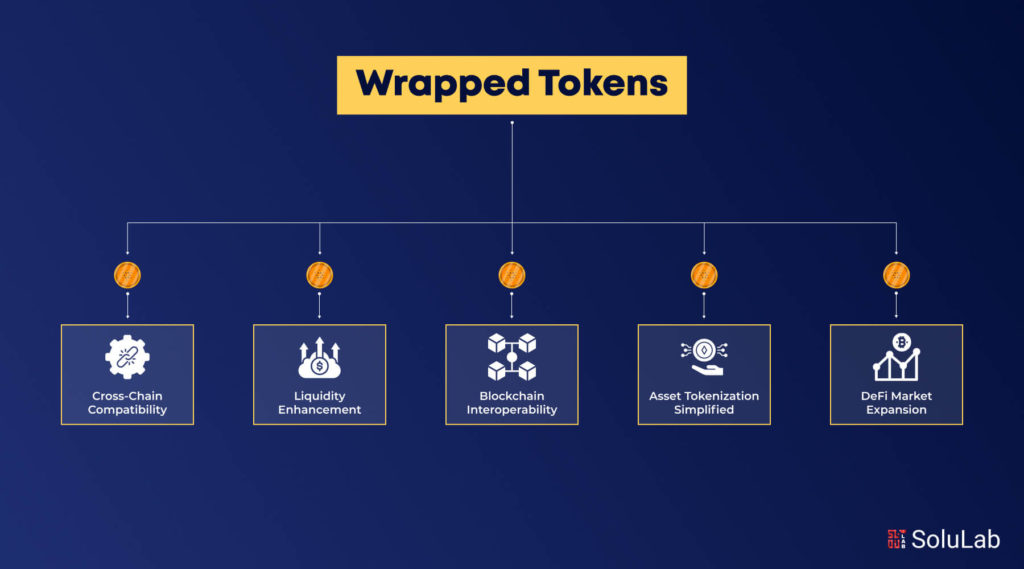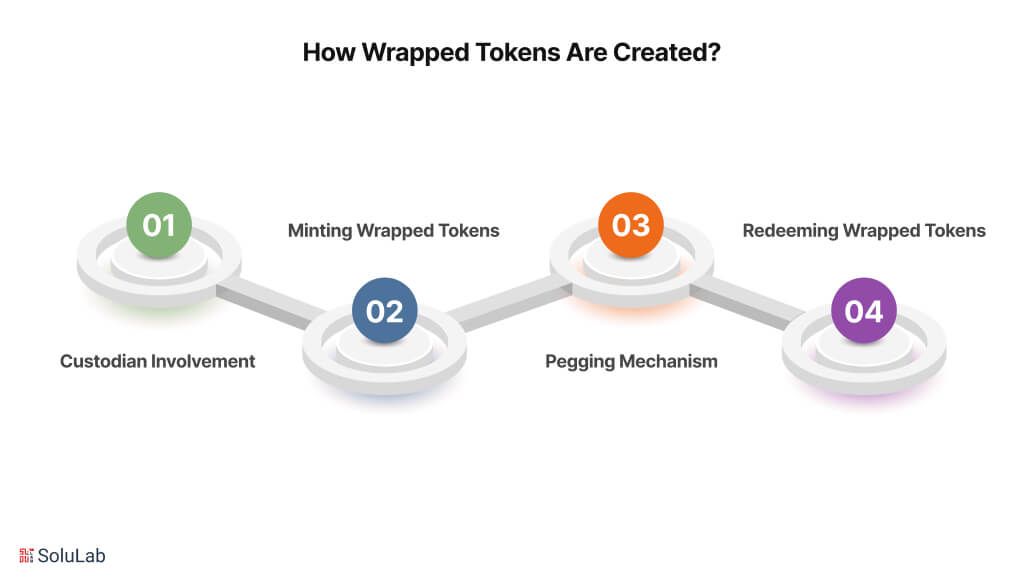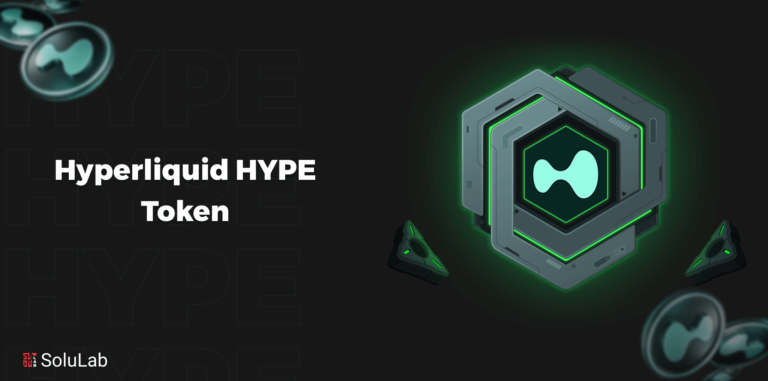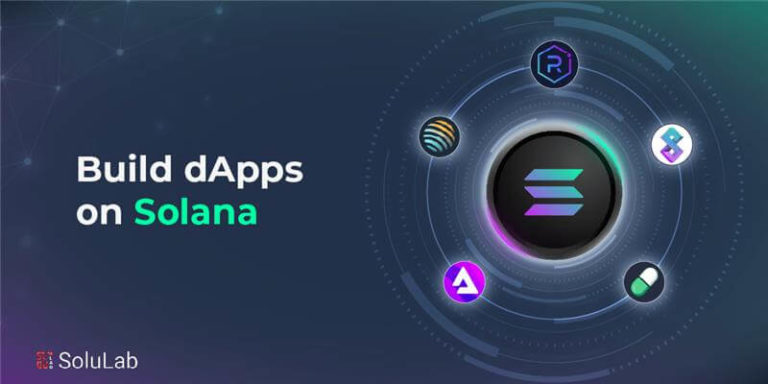
In recent years, the market for wrapped tokens has experienced a surge in growth, with Wrapped Bitcoin (wBTC) leading the way with a remarkable value of $10.58 billion. This figure surpasses the combined budgets of three small African countries.
At the time of writing, wBTC has seen a significant price increase of 1.7% in a single day, hovering around $68,443.00. This surge reflects the growing interest in wrapping digital assets to unlock new possibilities within the DeFi space. Collectively, the market cap for wrapped tokens has reached an impressive $12.1 billion.
The increasing market cap suggests that wrapped tokens like wBTC are gaining significant traction. Crypto thought leaders have expressed enthusiasm for the potential of wrapped tokens to change the DeFi world.
What are Wrapped Tokens?
Wrapped tokens, like Wrapped Bitcoin (WBTC), function as assets that facilitate the transfer of value from one blockchain to another. Wrap crypto mechanisms ensure that WBTC, in particular, maintains a 1:1 peg to the price of Bitcoin (BTC), guaranteeing that one WBTC always corresponds to one BTC. Unlike BTC, WBTC’s availability as ERC-20 and TRC-20 tokens enables its use and trading on the Ethereum and Tron blockchains.
In comparison to stablecoins like USDT, which mirror the value of the U.S. dollar, wrapped tokens share similarities. Just as one WBTC is tied to the price of one BTC, one USDT is pegged to $1. However, the defining aspect of a wrap token extends beyond its 1:1 price peg to another asset. It lies in the underlying technology and the mechanisms used to maintain and back its value.
The Role of Wrapped Tokens
Wrapped tokens serve as a link between different blockchain networks, enabling the utilization of non-native assets within diverse DeFi ecosystems. They fill the gap between blockchains by allowing assets to be seamlessly transferred and employed across various platforms. For instance, let’s consider Bitcoin and Ethereum. Bitcoin, operating on its own blockchain, cannot directly interact with smart contracts or DeFi applications built on Ethereum. However, by wrapping tokens like Bitcoin into an Ethereum-compatible wrapper token such as WBTC, users can access the functionality and liquidity of Bitcoin within the Ethereum DeFi ecosystem.
This wrapping process involves creating a representation of the original asset on a different blockchain. The wrapped token acts as a proxy, backed 1:1 by the underlying asset held in custody. When a user wraps their Bitcoin into WBTC, the wrapped token is minted on the Ethereum blockchain while the equivalent amount of Bitcoin is locked in a secure vault.
Wrapped tokens provide several key benefits for users and DeFi applications alike. They enhance interoperability, allowing for the integration of non-native assets into various blockchain networks. This expanded interoperability fosters innovation and enables the creation of more complex and sophisticated DeFi applications. Wrapped tokens also increase liquidity, as they open up new markets for non-native assets. By tapping into the liquidity of Ethereum’s DeFi ecosystem, Bitcoin holders can earn yield through lending, borrowing, or participating in decentralized exchanges.
Wrapped tokens play a significant role in the DeFi ecosystem by bridging the gap between different blockchains and expanding the functionality and liquidity of cryptocurrencies. They unlock new possibilities for DeFi developers and users, fostering innovation and driving the growth of the industry.
How Wrapped Tokens Are Created?

The process of creating wrapped tokens, also known as tokenization, involves several crucial steps:
1. Custodian Involvement:
- A custodian plays a vital role in the process. The custodian can be a centralized entity, a smart contract, or a decentralized autonomous organization (DAO).
- The custodian’s primary responsibility is to hold the original asset in reserve. For example, if Bitcoin is being wrapped, the custodian will hold the Bitcoin in their custody. This process is crucial to understand in the list of wrapped tokens, as it highlights how wrapped tokens are backed by the original asset. Understanding how do wrapped tokens work involves recognizing the custodian’s role in maintaining the integrity and value of the wrapped token.
2. Minting Wrapped Tokens:
- Once the original asset is in the custodian’s possession, the custodian initiates the minting process.
- Minting involves creating an equivalent amount of wrapped tokens on the target blockchain. For instance, if Bitcoin is being wrapped on the Ethereum blockchain, the custodian will mint an equivalent number of wrapped Bitcoin tokens (WBTC) on Ethereum.
3. Pegging Mechanism:
- To ensure the stability and credibility of wrapped tokens, each wrapped token is pegged 1:1 to the original asset. This means that the value of one wrapped token should always mirror the value of one unit of the original asset.
- The pegging mechanism plays a crucial role in maintaining the price parity between the wrapped token and the original asset.
4. Redeeming Wrapped Tokens:
- When users wish to convert their wrapped tokens back to the original asset, they can initiate a redemption process through the custodian.
- The custodian verifies the user’s request and burns (destroys) the wrapped tokens from circulation.
- Once the wrapped tokens are burned, the custodian releases the equivalent amount of the original asset to the user. This process ensures that the supply of wrapped tokens is always backed by the original asset held in reserve by the custodian.
The tokenization process allows users to interact with assets from different blockchains seamlessly. It enables cross-chain compatibility, liquidity enhancement, the exploration of new financial opportunities, and real world asset tokenization. However, it’s important to note that the security and reliability of wrapped tokens heavily depend on the trustworthiness of the custodian and the underlying infrastructure.
Popular Examples of Wrapped Tokens
Here are some popular examples of wrapped tokens:
- Wrapped Bitcoin (WBTC): Wrapped Bitcoin (WBTC) is an ERC-20 token on the Ethereum blockchain that is backed 1:1 by Bitcoin. This means that for every WBTC in circulation, there is an equivalent amount of Bitcoin held in reserve by a trusted custodian. WBTC was created by BitGo, a digital asset custody provider, in January 2019. It allows Bitcoin holders to participate in Ethereum’s DeFi ecosystem, which offers a wide range of decentralized financial applications such as lending, borrowing, trading, and more. WBTC has a market capitalization of over $3.5 billion and is the most popular tokenized version of Bitcoin.
- renBTC: renBTC is another tokenized version of Bitcoin on the Ethereum blockchain. However, unlike WBTC, which is backed by a centralized custodian, renBTC is backed by the Ren protocol. Ren is a decentralized network that allows for the trustless transfer of assets between different blockchains. This means that renBTC holders do not have to rely on a third party to hold their Bitcoin in reserve. RenBTC was created in May 2020 and has a market capitalization of over $400 million. It offers a number of advantages over WBTC, such as lower fees and faster transaction times.
- Wrapped Ethereum (WETH): Wrapped Ethereum (WETH) is an ERC-20 token that represents Ethereum. It was created in 2017 by the decentralized exchange Uniswap. WETH is created by depositing ETH into a smart contract and receiving an equivalent amount of WETH in return. WETH can then be used in DeFi applications that require ERC-20 tokens, such as decentralized exchanges, lending platforms, and yield farming protocols. WETH has a market capitalization of over $2 billion and is the most popular wrapped token on the Ethereum blockchain. The distinction between layer 1 vs. layer 2 solutions also plays a role here, as WETH operates on Ethereum’s layer 1, but can interact with layer 2 scaling solutions to enhance transaction speed and reduce costs in DeFi applications.
- Wrapped BNB (WBNB): Wrapped BNB (WBNB) is a tokenized version of Binance Coin (BNB) that can be used on the Ethereum network. It was created by Binance in April 2019. WBNB is created by depositing BNB into a Binance Smart Chain (BSC) smart contract and receiving an equivalent amount of WBNB in return. WBNB can then be used in DeFi applications on Ethereum, such as decentralized exchanges, lending platforms, and yield farming protocols. WBNB has a market capitalization of over $1 billion and is the most popular wrapped token on the BSC. The concept of multi-chain vs. cross-chain becomes relevant here, as WBNB facilitates cross-chain interactions, allowing BNB to be utilized in Ethereum’s DeFi ecosystem.
Benefits of Wrapped Tokens
Wrapped tokens, as a significant innovation in the cryptocurrency industry, offer a range of benefits that enhance the functionality and accessibility of cryptocurrencies. These advantages contribute to the overall growth and adoption of digital assets:
Interoperability:
- Wrapped tokens act as a bridge between different blockchains, enabling the seamless transfer of assets across various networks. This interoperability is crucial for the development of a connected and inclusive blockchain ecosystem.
- By allowing assets to be moved between blockchains, wrapped tokens facilitate cross-chain transactions, collaborations, and the exchange of value in a more efficient and cost-effective manner.
Liquidity:
- Wrapped tokens increase the liquidity of non-native assets by making them available for use in various DeFi protocols and decentralized applications (dApps).
- This expanded liquidity pool attracts traders, investors, and liquidity providers, resulting in deeper markets and more competitive pricing for wrapped assets.
- It also enhances the overall efficiency of the DeFi ecosystem by enabling users to seamlessly access a wider range of assets for lending, borrowing, staking, and other financial activities.
Accessibility:
- Wrapped tokens simplify the process of accessing and using cryptocurrencies across different platforms.
- By wrapping non-native assets, users can interact with various DeFi protocols, wallets, and exchanges without having to go through complex conversion processes or face limitations imposed by certain platforms.
- This accessibility opens up new opportunities for individuals and institutions to participate in the cryptocurrency market, regardless of their technical expertise or the specific blockchain network they prefer.
Efficiency:
- When users wish to convert their wrapped crypto back to the original asset, they can initiate a redemption process through the custodian.
- The custodian verifies the user’s request and burns (destroys) the wrapped tokens from circulation.
- Once the wrapped tokens are burned, the custodian releases the equivalent amount of the original asset to the user. This process ensures that the supply of wrapped tokens is always backed by the original asset held in reserve by the custodian. This is a critical part of understanding wrapping crypto and what is wrapping crypto, as it illustrates the mechanism behind the wrapped token process.
Wrapped tokens are upgrading the cryptocurrency by breaking down barriers between blockchains, increasing liquidity, improving accessibility, and enhancing transaction efficiency. These advantages position wrapped tokens as key enablers for the mainstream adoption and growth of the cryptocurrency industry.
Related: Guide to DeFi Yield Farming
Potential Risks and Challenges
Wrapped tokens offer several advantages such as enhanced liquidity, accessibility, and interoperability. However, they also come with certain risks and challenges that investors and users should be aware of:
1. Custodial Risk:
Wrapped tokens depend on custodians, usually centralized entities, to hold the original assets. The security of wrapped tokens is highly reliant on the custodian’s integrity and operational practices. If the custodian is compromised due to a cyber attack, internal fraud, or mismanagement, it could lead to the loss of the underlying assets and the devaluation of wrapped tokens. Understanding what is wrapped crypto and what are wrapped tokens helps illustrate how wrapped crypto functions. What does wrapped mean in crypto in this context refers to the reliance on the custodian to maintain the value and security of the wrapped assets, introducing counterparty risk as investors must trust the custodian’s ability to safeguard their assets.
2. Smart Contract Risk:
The minting and burning mechanisms of wrapped tokens are facilitated through smart contracts. While smart contracts offer transparency and automation, they can also introduce vulnerabilities if not developed and audited thoroughly. Bugs, exploits, or vulnerabilities in the code could allow unauthorized access to funds or manipulation of the token supply. Smart contract risk is particularly concerning for wrapped tokens as they involve complex interactions between multiple blockchains and often rely on third-party protocols. As we look towards The Future of Blockchain?, addressing these risks will be crucial for ensuring the security and reliability of wrapped tokens.
3. Regulatory Risk:
Wrapped tokens may face regulatory scrutiny due to their cross-chain nature and the involvement of custodial services. Regulators may classify wrapped tokens as securities or financial instruments, subjecting them to licensing, registration, and compliance requirements. This regulatory uncertainty could impact the availability and legality of wrapped tokens in certain jurisdictions, potentially affecting their liquidity and value.
4. Liquidity Risk:
While wrapped tokens aim to increase liquidity by bridging different blockchains, their liquidity is ultimately tied to the liquidity of the underlying asset and the trust in the custodian. If the underlying asset experiences low trading volume or liquidity issues, wrapped tokens may also suffer from reduced liquidity. Additionally, if the custodian faces liquidity challenges or becomes insolvent, it could impact the ability of investors to redeem their wrapped tokens for the underlying assets. This risk highlights the importance of asset tokenization and the need for reliable custodians to maintain confidence in the market.
Future of Wrapped Tokens
Wrapped tokens, a type of token representing underlying assets, are gaining attention in the cryptocurrency market. Factors like innovations in DeFi, advancements in Blockchain Working, development of new protocols, and regulatory clarity are driving their demand. Wrapped tokens facilitate cross-chain transactions and interoperability, enabling users to access a wider range of markets and opportunities. They are used for cross-chain trading, DeFi lending and borrowing, staking and yield farming, and real-world asset tokenization. As DeFi grows and blockchain technology advances, wrapped tokens will become increasingly important in the future, playing a vital role in the seamless transfer and trading of assets across different blockchains.
Conclusion
In conclusion, wrapped tokens are a pivotal innovation in the blockchain ecosystem, bridging different blockchains and enhancing the liquidity and interoperability of digital assets. They enable users to leverage the unique features of various blockchain networks, such as speed, security, and lower transaction fees, without losing access to their original assets. This interoperability fosters a more integrated and versatile crypto economy, making wrapped tokens a valuable tool for both individual and institutional investors. For businesses and developers looking to explore the potential of wrapped tokens, wrapped tokens development services are essential. These services ensure the seamless creation and integration of wrapped tokens into your blockchain projects, providing robust security and efficiency. Partnering with a wrapped tokens development company like SoluLab can significantly streamline this process. SoluLab offers comprehensive solutions tailored to meet your specific needs, from initial concept to deployment, ensuring that your wrapped token implementation is both effective and secure.
If you’re looking to expand your blockchain capabilities and enhance your platform’s functionality, consider the benefits of wrapped tokens. To achieve the best results, it’s crucial to hire wrapped tokens developers who possess the expertise and experience needed to navigate the complexities of blockchain technology. SoluLab’s team of dedicated developers stands out in this field, offering top-notch development services that can help you achieve your goals efficiently and securely. By leveraging the expertise of professionals and incorporating advanced technological solutions, you can ensure that your venture into the world of wrapped tokens is both successful and sustainable. Embrace the future of blockchain with confidence, knowing that SoluLab and its wrapped tokens development services are here to support you every step of the way.
FAQs
1. What are wrapped tokens?
Wrapped tokens are a type of digital asset designed to represent another cryptocurrency on a different blockchain. The process involves “wrapping” the original asset within a smart contract, which then issues an equivalent token on a different blockchain. This mechanism facilitates interoperability between different blockchain networks. By using wrapped tokens, users can trade and utilize their assets across various platforms while maintaining the value of the original cryptocurrency.
2. How do wrapped tokens work?
The functioning of wrapped tokens involves a process where the original asset is secured in a smart contract, and a corresponding amount of the wrapped version is minted on the target blockchain. For instance, wrapping tokens such as Bitcoin on Ethereum involves locking Bitcoin in a secure smart contract and creating Wrapped Bitcoin (WBTC) on the Ethereum network. This process ensures that the total supply of both the wrapped and original tokens remains balanced, thereby preserving their value equivalence.
3. What is wrapping in crypto?
In the context of cryptocurrencies, wrapping refers to the technique of creating wrapped tokens by locking an asset in a smart contract and generating a corresponding token on another blockchain. This process enhances the interoperability and liquidity of the asset across various blockchain networks. Wrapping in crypto allows users to utilize their assets in different blockchain environments without sacrificing the value or utility of their original holdings.
4. How to create a wrapped token?
Creating a wrapped token involves several key steps. Initially, the original asset is locked in a secure smart contract. Following this, an equivalent amount of the wrapped token is minted on the target blockchain. To ensure the integrity and value of the wrapped token, it must be redeemable for the original asset at any time. Engaging a wrapped tokens development service or a reputable wrapped tokens development company like SoluLab can provide the necessary expertise to ensure a smooth and secure wrapping process.
5. What does wrapped mean in crypto?
In cryptocurrency terms, wrapped signifies the process of converting an asset into a different form that can be used on another blockchain. Wrapped tokens maintain the value of the original cryptocurrency while being functional on different platforms. This method of wrapping crypto enables the asset to be utilized across various blockchain ecosystems, enhancing its utility and integration within the broader crypto space.
6. What are the benefits of wrapped tokens?
The primary benefits of wrapped tokens include increased liquidity and enhanced interoperability between blockchain networks. By allowing assets to be used across different platforms, wrapping crypto enables users to leverage their assets in various decentralized finance (DeFi) applications. Additionally, wrapped tokens preserve the value of the original asset, ensuring it remains redeemable and valuable within the new blockchain context. This flexibility and utility make wrapped tokens a valuable component in the evolving landscape of digital assets.






